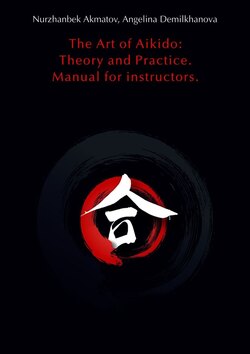Читать книгу The Art of Aikido: Theory and Practice. Manual for instructors - Angelina Demilkhanova - Страница 2
AIKIDO: THEORY AND PRACTISE
ОглавлениеManual for instructors
Nurzhanbek Akmatov
Angelina Demilkhanova
translated into english by Gulizat Bekmurzaeva
When a person walks along the Samurai Path, he should not look for other ideals. The same goes for the Path itself. Therefore, it is wrong to study the Way of Confucius or the Way of Buddha and say that this is the Way of the Samurai. If a person understands this, he will listen to sermons about other Ways, but at the same time, more and more will learn his own.
Yamamoto Tsunetomo (Book One)
PSYCHOLOGICAL ASPECTS OF AIKIDO. introduction
One acquaintance asked me: «What do you feel when practicing aikido?» And I replied: «I feel spontaneity, creativity, freedom. I feel that I am a person, a living real person»
The main difference between sporting activity and martial arts roots in the principles – fundamental principles of life. Inasmuch that the martial art – is a science of life, which has a centuries-long history.
Any martial art is based on the fact that it has several components – physical exercises (kata, techniques, muscle development, reaction speed, training of attention, etc.), the psychological component – to know yourself, and then learn to control yourself (achieved by physical training, practicing with partners or a sparring system, breathing exercises, various forms of meditative techniques, etc.), and the spiritual component, which is based on understanding of the very essence of a human nature, his existence in his own world, the world with other people and the world of surrounding nature (this component is mainly based on the philosophical principles of the foundation of martial arts, which, depending on the country and continent, may be represented by Zen Buddhism, Buddhism, Confucianism, Taoism, Hinduism, etc.).
When creating aikido, the founder Morihei Ueshiba focused on harmonizing the spirit and merging with vital energy («Ki», «Chi» or «Qi» in the Chinese tradition). In this regard, great importance in aikido is given to working with Ki energy, breathing, the ability to control not only your body and yourself, use the energy of its movements against it, but also to complete the technique so as not to harm your opponent (partner).
«Genuine martial art should have nothing to do with either brute physical force, which is necessary only to overthrow the enemy, and even more than with any deadly weapon that lead the world to destruction. Genuine martial art is called upon by avoiding a fierce struggle to regulate universal Ki, preserving peace, and allowing everything to grow and develop in nature. Thus, exercises in any form of martial arts should not be a goal in itself for the destruction of the enemy, but, on the contrary, should develop a sense of love and respect for others.»1
Angelina Demilkhanova.
1
A. Dolin, G. Popov. Kempo – martial arts tradition. М., 1992, pp. 320—321
